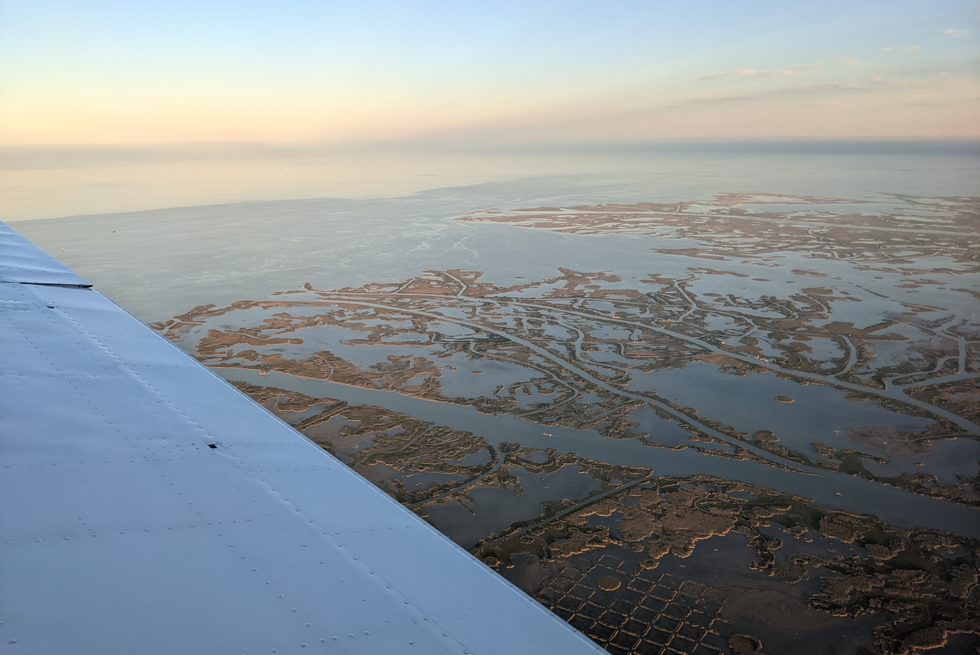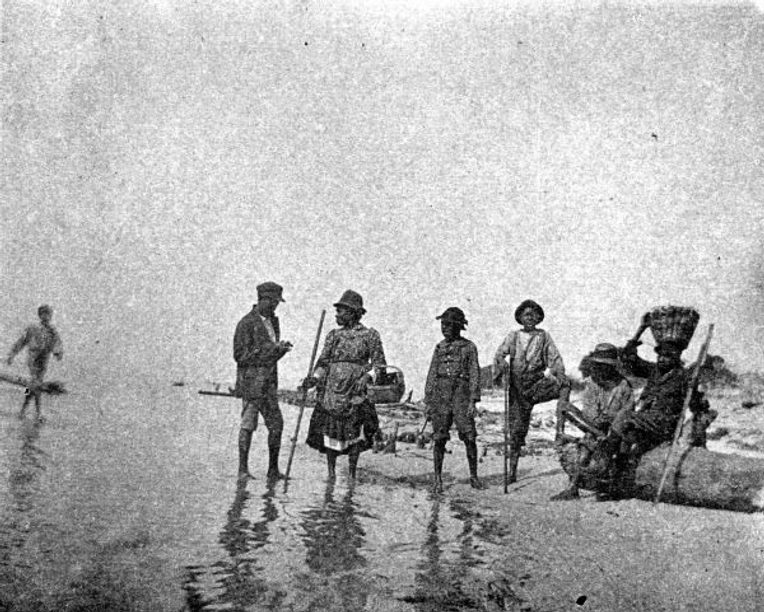Oyster Futurities: More-than-Human Kinship and the Humble Mollusk
From the Series: Coastal Futures
From the Series: Coastal Futures

Within the State of Florida archival collection, in a file folder labeled “Franklin County,” is an 1895 photograph of a group of Black Americans standing along a shoal in the Apalachicola Bay in the Florida Gulf.[1]
The most striking person in the photograph is a woman—she is ankle deep in the water, looking forward. A long wooden pole is in her hand. It is used for harvesting oysters in a method called tonging (Figure 1). A woven basket is in her other hand, likely filled with oysters.

Apalachicola is known for its oysters. At one point the town provided almost 10 percent of oysters for the entirety of the United States (Pine et al. 2015). Today, the fishery is closed to wild harvesting, yet futures are found within the possibility to regrow reefs via oyster aquaculture. These hypothetical plans face forward, toward the future, with an attunement to the present. Oyster reefs, along with marshes and seagrasses are considered a part of coastal infrastructure, known as living shorelines, fostered to prevent costal erosion and limit storm surge from the certainty of intensifying storms in coastal futures.[2] Reefs are alternatives to hard coastal stabilization techniques, such as seawalls that have additional adverse effects such as increased erosion in front of seawalls and in adjacent coastal areas. As we consider the oyster as part of coastal infrastructure solutions, it remains imperative to re-center this mollusk’s deeply held connections to Black life under the continuous intertwined conditions of environmental degradation and racial capitalism across the Eastern Seaboard.
The oyster has always been a source of Black American foodways and a space of radical Black imagining.[3] Oyster reefs themselves are a critical aspect of Black Southern Geographies—pockets of harvesting across the East Coast’s waters have supported spaces of Black American life in journeys toward forged freedom and acts of survival.[4] We can look at the organism’s diasporic roots. Benin, a major location for the Trans-Atlantic slave trade, has historically had major cultural connections to fishing and shell-fishing (Belhabib and Pauly 2015). Underwater divers of the Western Ivory Coast and Kru maritime peoples of Liberia, harvested oyster for their protein and utilized their shells for lime in construction (Dawson 2018).
Diverse knowledges of oysters as foodways in estuarine and mangrove ecosystems likely traveled across the Atlantic as a tradition carried on from the regions of the western Ivory Coast, arriving to merge with long held Indigenous relationships with the mollusk in the Americas. The oyster is an unassuming creature upon which to place our collective futures, but oyster-human relationships, entanglements of multi-species kinship are long and old relationships and that have been managed throughout time (Reeder-Myers et al. 2022). Here I am following the lead of scholar J.T. Roane in his analysis of subaquatic Black life in Tidewater, Virginia. The estuary waters of the Southeastern United States are much like that of the brackish Tidewater—locations in which oysters simultaneously bring to light shared Black and Indigenous histories and lineages, as well as attune our attention to the murkiness between them.
In considering our collective futures, as sea levels rise and storm surges increasingly threaten our coastlines, the oyster provides a guiding light towards a future that is radically interconnected and centered on more-than-human kinship. For Black and Indigenous people, the threat of the Anthropocene and of world-ending events is not new—the act of survival, a given, rather than an optional course of action (Yusoff 2018). The ongoing projects of settler colonialism and enslavement have worked to sever Black and Indigenous connections to land, water and foodways in pursuit of their disappearance, yet these lives remain.
If the oyster-human relationship has not always been one of shared care and attunement towards futurity, the ushering of harmful environmental degradation into oyster worlds has been directly linked to the expansion and racialization of that industry. In the nineteenth century, efforts to remove Black oyster tongers through discriminatory hiring practices accompanied an era of damaging dredging to achieve maximum yield during harvest.[5] This marked a beginning to future oyster fishery collapses along the Atlantic coastline. Considering that living-with the oyster was once a given form of life, we must consider and acknowledge that oyster reefs are active agents of our collective future.[6] And while oysters have not always been categorized as infrastructure, as urban geographer Stephanie Wakefield articulates—contemporary coastal management in the Anthropocene should lean into what the oyster has provided—its historical connections and it’s Indigenous and African diasporic roots—remaining attuned to the intertwined socio-ecological history of the organism within Black and Indigenous coastal peoples (Wakefield 2020).
The American Atlantic coastline remains a site where we can critically understand Black Geographies. Recentering the oyster as part of the coastal infrastructure needed to address the conditions of climate change created by settler colonialism and racial capitalism indeed feels like a natural regression towards an organism that has already been a part of Black and Indigenous survival. What might it mean to create living shorelines that are also acts of living history? In Apalachicola, such a reframing would require coastal management practices to remain attuned to imaginative possibilities, while considering the materiality of the continuous conditions that have always existed for some along with acts of aqueous kinship that aspire towards muddy futures.
[1] Tiffany Lethabo King (2019) asks us to pay particular attention to the shoal as a dynamic location of Black and Indigenous relations: “It is mobile, always changing and shifting state of flux.” In addressing collective futures on the coastline, it is imperative to attend to the shoal as a site of shifting Black Geographies.
[2] https://www.habitatblueprint.noaa.gov/living-shorelines/
[3] See Ayasha Guerin’s (2019) on the history of oysters, the Downing family, and Black liberation movements in New York.
[4] See J.T. Roane’s work (2022) for more on Black subaquatic life in Chesapeake through the lens of oysters, fish crab and clams.
[5] In her analysis of the nineteenth century New York oyster industry, Guerin references Peter J. Jacques work, The Origins of Coastal Ecological Decline and the Great Atlantic Oyster (2017). Jacques states “Once the tongers were largely out of the picture, oystering was a hierarchically organized industrial effort using dredges to maximize catch (Jacques 2017). Guerin extends on this, linking increased industrialization to decreased Black participation in the oyster fishery.
[6] Haraway discusses the concept of living-with and dying within her work (2016). Stephanie Wakefield references Donna Haraway’s “Situated Knowledge” (1988) in discussing see the oyster as an active agent.
Dawson, Kevin. 2018. Undercurrents of Power: Aquatic Culture in the African Diaspora. Pittsburgh: University of Pennsylvania Press,.
Belhabib, Dyhia, and Daniel Pauly. 2015. “Benin’s Fisheries: A Catch Reconstruction.” Fisheries Catch Reconstructions: West Africa, Part II, 51-64.. Vancouver: Fisheries Centre, University of British Columbia.
Guerin, Ayasha. 2019. “Underground and at Sea: Oysters and Black Marine Entanglements in New York’s Zone-A.” Shima 13, no. 2.
Haraway, Donna J. 1988. “Situated Knowledges: The Science Question in Feminism and the Privilege of Partial Perspective.” Feminist Studies 14, no. 3: 575-599.
Haraway, Donna J. 2016. Staying with the Trouble: Making Kin in the Chthulucene. Durham, N.C.: Duke University Press,.
Jacques, Peter J. 2017. “The Origins of Coastal Ecological Decline and the Great Atlantic Oyster Collapse.” Political Geography 60: 154-164.
King, Tiffany Lethabo. 2019. The Black shoals: Offshore Formations of Black and Native Studies. Durham, N.C.: Duke University Press.
Pine, William E., Carl J. Walters, Edward V. Camp, Rachel Bouchillon, Robert Ahrens, Leslie Sturmer, and Mark E. Berrigan. 2015. “The Curious Case of Eastern Oyster Crassostrea Virginica Stock Status in Apalachicola Bay, Florida.” Ecology and Society 20, no. 3.
Reeder-Myers, Leslie, Todd J. Braje, Courtney A. Hofman, Emma A. Elliott Smith, Carey J. Garland, Michael Grone, Carla S. Hadden et al. 2022. “Indigenous Oyster Fisheries Persisted for Millennia and Should Inform Future Management.” Nature Communications 13, no. 1: 2383.
Roane, J. T. 2022. “Black Ecologies, Subaquatic Life, and the Jim Crow Enclosure of the Tidewater.” Journal of Rural Studies 94: 227-238.
Yusoff, Kathryn. 2018. A Billion Black Anthropocenes or None. Minneapolis: University of Minnesota Press,.
Wakefield, Stephanie. 2020. “Making Nature into Infrastructure: The Construction of Oysters as a Risk Management Solution in New York City.” Environment and Planning E: Nature and Space 3, no. 3: 761-785.